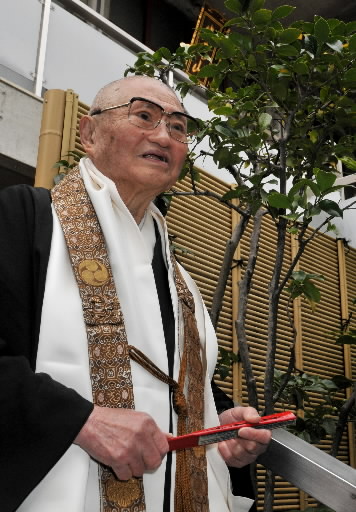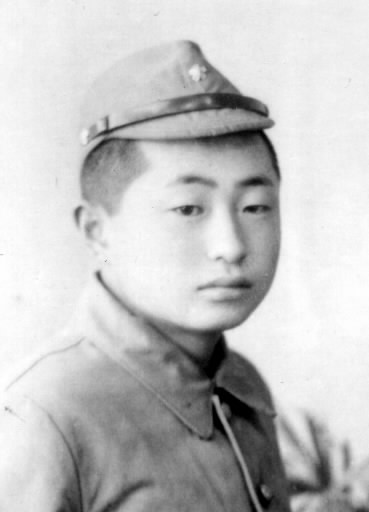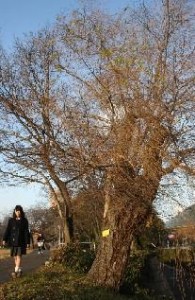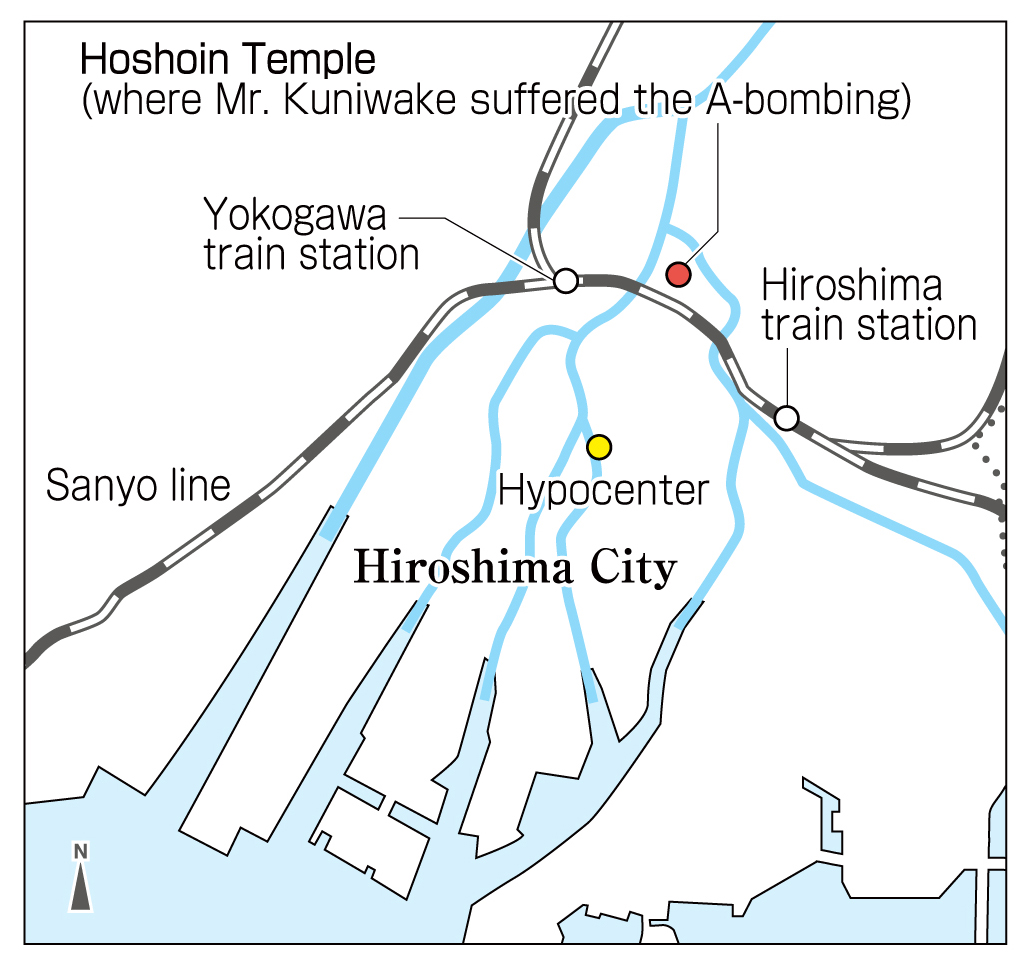Yoshinori Kuniwake, 82, Naka Ward, Hiroshima
Jun. 25, 2012
Encouraged by A-bombed trees
Mother and three siblings perish: Gave seedlings to students with wish for peace
Yoshinori Kuniwake, 82, the former head priest of Hoshoin Temple in Naka Ward, Hiroshima gazed at the A-bombed camellia and linden trees on the temple grounds. "These trees, which had the strength to survive the atomic bombing despite their wounds, helped encourage me to go on living," he said. Hoshoin Temple is located 1.7 kilometers from the bomb's hypocenter. Mr. Kuniwake was there at the temple when the blast occurred on the morning of August 6, 1945. The bomb stole the lives of his mother and his siblings.
Back then, he lived in a home on the temple grounds with his parents, two brothers, and four sisters. He was 16 and attending present-day Sanyo High School. One of the many students mobilized for the war effort, Mr. Kuniwake was set to leave his house to bring lunch boxes to a military factory. Just then he heard the sound of a plane and a flash lit up the sky. He was blown into the air, through the smell of debris and dirt. Although he lost consciousness for a moment, he awoke to find a shaft of sunlight. He eagerly moved in that direction and was able to escape the wreckage of his home.
His father Chitoku, 46, and his younger brother Yoshifumi, 11, managed to survive the collapse of the house, too. They found his younger sister Keiko, 4, crying amid the debris and went to her aid. He then searched the vicinity and saw his mother Haruko, 41, holding his brother Hironobu, just a year old. But Haruko and Hironobu had gotten caught under a falling beam and were dead.
As flames closed in, the surviving members of his family had no choice but to flee. Houses on both sides of the road were on fire so, to prevent burns, they first soaked in a water cistern designed for fire fighting. Then they dashed down the road as quickly as they could.
That night, they returned to the temple and slept out in the open. The temple buildings continued to burn and Mr. Kuniwake recalls seeing red and blue flames rising in the air, beneath a linden tree that had escaped the fire. "Which flames came from my mother and my brother?" he wondered. "I shouldn't have fled. I should have stayed behind and died with them." He could not stop weeping.
His older sister Nobuko, 18, was working at a factory as a member of the women's volunteer corps and survived the bombing, too. But his younger sister, Ikuko, 14, who was mobilized to work outdoors that day, had burns all over her body and died from her injuries. The whereabouts of another younger sister, Kazuko, 7, was unknown, until later her bones were discovered on the temple grounds.
After the war came to an end, his family was thinking of leaving Hiroshima and starting fresh in another city. But when they saw taro plants begin to sprout, this encouraged them to continue living here.
Mr. Kuniwake suffered injuries to his forehead and chest when his home collapsed. He received medical care in Kagawa Prefecture, where relatives lived, and then followed a teacher's advice and returned to high school in November of 1945. After graduating, he went to work at a post office and engaged in training to become a temple priest. In 1970, he took over the family temple by becoming the 18th head priest. He then handed this role over to his eldest son in 2001.
Mr. Kuniwake hopes that "Everyone will hold thoughts for peace and value the idea of harmony." He said, "Let's reflect on the emptiness of war and the importance of peace by looking at the trees which have survived in Hiroshima when it was said that no plants would grow here." In 2002, Mr. Kuniwake offered seedlings grown from the seeds of the temple's A-bombed linden tree to Hakushima Elementary School, located nearby. He hopes that the feeling of cherishing peace will grow in the students' minds. (Sakiko Masuda, Staff Writer)
A-bombed trees: Preserving "living witnesses" of the bombing
A-bombed trees have endured the ravages of war and stand as "living witnesses" of the atomic bombing. According to the City of Hiroshima, about 170 trees within a 2-kilometer radius of the hypocenter survived the blast. These trees are located at 55 sites in this area and include 32 species, such as plane trees and Japanese hackberry.
The tree closest to the hypocenter is a weeping willow, which stands 370 meters away in Motomachi. Although the original tree was toppled by the bomb, a new shoot appeared at the base of tree.
In order to preserve the A-bombed trees and hand them down to the next generation, the Hiroshima city government has conducted research on the trees since 1996 and has registered the trees that stand on the grounds of public buildings, temples, and shrines. Those trees now bear plates which carry explanation about the atomic bombing.
The city also cares for the trees to prevent the roots from dying and to remove harmful insects. Despite this care, some trees have withered. At the same time, there are instances in which A-bombed trees located on private property have been transplanted to elementary schools and then added to the list of registered trees.
Seeds and seedlings from A-bombed trees are shared by the city and Hiroshima citizens with people in Japan and overseas, and these new trees are now growing in places all over the world. At elementary schools and junior high schools which maintain A-bombed trees, the trees are a useful addition to their peace education efforts.
Teenagers’ impressions
Mutual understanding is important
I was very impressed by his words: "To create peace in the world, I would like everyone to feel strongly about peace and join these individual feelings together." It's important to stop hatred and try to understand one another. If we come to see the value of others, that would lead to peace. As my life goes on, I want to keep his words in mind. (Chin Iyo, 15)
A-bomb experience is painful
He looked really sad when we were asking questions about his experience of the atomic bombing. Talking about these experiences isn't an easy thing; it takes a lot of energy. I felt again the importance of listening to their stories closely. I want to maintain compassion for others and take action to help build a peaceful world. (Ren Nonaka,17)
Staff Writer’s Notebook
Hoshoin Temple was established in the Azuchi-Momoyama Period (1568-1598). In the cemetery located on the south side of the temple is a monument to the writer Yoko Ota (1903-1963), who produced a large body of work about the atomic bombing. The monument was erected by Mr. Kuniwake in 2010.
Mr. Kuniwake knew Ms. Ota, who experienced the bombing in a house in the same neighborhood. Her well-known book, "City of Corpses," includes a part about Mr. Kuniwake's family. Correcting part of her description in the book, he engraved on the stone monument: "At this temple, a wife, her baby, and her seven-year-old daughter died under the destroyed building."
In addition to the surviving camellia and linden trees, Hoshoin Temple has preserved A-bombed artifacts, including a statue of Buddha and melted roof tiles. Mr. Kuniwake still keeps the memories of his lost mother, brother, and sisters in his heart. He holds dear those things which speak of the cruelty of the atomic bomb with no words at all. (Sakiko Masuda, Staff Writer)
(Originally published on January 23, 2012)
Mother and three siblings perish: Gave seedlings to students with wish for peace
Yoshinori Kuniwake, 82, the former head priest of Hoshoin Temple in Naka Ward, Hiroshima gazed at the A-bombed camellia and linden trees on the temple grounds. "These trees, which had the strength to survive the atomic bombing despite their wounds, helped encourage me to go on living," he said. Hoshoin Temple is located 1.7 kilometers from the bomb's hypocenter. Mr. Kuniwake was there at the temple when the blast occurred on the morning of August 6, 1945. The bomb stole the lives of his mother and his siblings.
Back then, he lived in a home on the temple grounds with his parents, two brothers, and four sisters. He was 16 and attending present-day Sanyo High School. One of the many students mobilized for the war effort, Mr. Kuniwake was set to leave his house to bring lunch boxes to a military factory. Just then he heard the sound of a plane and a flash lit up the sky. He was blown into the air, through the smell of debris and dirt. Although he lost consciousness for a moment, he awoke to find a shaft of sunlight. He eagerly moved in that direction and was able to escape the wreckage of his home.
His father Chitoku, 46, and his younger brother Yoshifumi, 11, managed to survive the collapse of the house, too. They found his younger sister Keiko, 4, crying amid the debris and went to her aid. He then searched the vicinity and saw his mother Haruko, 41, holding his brother Hironobu, just a year old. But Haruko and Hironobu had gotten caught under a falling beam and were dead.
As flames closed in, the surviving members of his family had no choice but to flee. Houses on both sides of the road were on fire so, to prevent burns, they first soaked in a water cistern designed for fire fighting. Then they dashed down the road as quickly as they could.
That night, they returned to the temple and slept out in the open. The temple buildings continued to burn and Mr. Kuniwake recalls seeing red and blue flames rising in the air, beneath a linden tree that had escaped the fire. "Which flames came from my mother and my brother?" he wondered. "I shouldn't have fled. I should have stayed behind and died with them." He could not stop weeping.
His older sister Nobuko, 18, was working at a factory as a member of the women's volunteer corps and survived the bombing, too. But his younger sister, Ikuko, 14, who was mobilized to work outdoors that day, had burns all over her body and died from her injuries. The whereabouts of another younger sister, Kazuko, 7, was unknown, until later her bones were discovered on the temple grounds.
After the war came to an end, his family was thinking of leaving Hiroshima and starting fresh in another city. But when they saw taro plants begin to sprout, this encouraged them to continue living here.
Mr. Kuniwake suffered injuries to his forehead and chest when his home collapsed. He received medical care in Kagawa Prefecture, where relatives lived, and then followed a teacher's advice and returned to high school in November of 1945. After graduating, he went to work at a post office and engaged in training to become a temple priest. In 1970, he took over the family temple by becoming the 18th head priest. He then handed this role over to his eldest son in 2001.
Mr. Kuniwake hopes that "Everyone will hold thoughts for peace and value the idea of harmony." He said, "Let's reflect on the emptiness of war and the importance of peace by looking at the trees which have survived in Hiroshima when it was said that no plants would grow here." In 2002, Mr. Kuniwake offered seedlings grown from the seeds of the temple's A-bombed linden tree to Hakushima Elementary School, located nearby. He hopes that the feeling of cherishing peace will grow in the students' minds. (Sakiko Masuda, Staff Writer)
Hiroshima Insight
A-bombed trees: Preserving "living witnesses" of the bombing
A-bombed trees have endured the ravages of war and stand as "living witnesses" of the atomic bombing. According to the City of Hiroshima, about 170 trees within a 2-kilometer radius of the hypocenter survived the blast. These trees are located at 55 sites in this area and include 32 species, such as plane trees and Japanese hackberry.
The tree closest to the hypocenter is a weeping willow, which stands 370 meters away in Motomachi. Although the original tree was toppled by the bomb, a new shoot appeared at the base of tree.
In order to preserve the A-bombed trees and hand them down to the next generation, the Hiroshima city government has conducted research on the trees since 1996 and has registered the trees that stand on the grounds of public buildings, temples, and shrines. Those trees now bear plates which carry explanation about the atomic bombing.
The city also cares for the trees to prevent the roots from dying and to remove harmful insects. Despite this care, some trees have withered. At the same time, there are instances in which A-bombed trees located on private property have been transplanted to elementary schools and then added to the list of registered trees.
Seeds and seedlings from A-bombed trees are shared by the city and Hiroshima citizens with people in Japan and overseas, and these new trees are now growing in places all over the world. At elementary schools and junior high schools which maintain A-bombed trees, the trees are a useful addition to their peace education efforts.
Teenagers’ impressions
Mutual understanding is important
I was very impressed by his words: "To create peace in the world, I would like everyone to feel strongly about peace and join these individual feelings together." It's important to stop hatred and try to understand one another. If we come to see the value of others, that would lead to peace. As my life goes on, I want to keep his words in mind. (Chin Iyo, 15)
A-bomb experience is painful
He looked really sad when we were asking questions about his experience of the atomic bombing. Talking about these experiences isn't an easy thing; it takes a lot of energy. I felt again the importance of listening to their stories closely. I want to maintain compassion for others and take action to help build a peaceful world. (Ren Nonaka,17)
Staff Writer’s Notebook
Hoshoin Temple was established in the Azuchi-Momoyama Period (1568-1598). In the cemetery located on the south side of the temple is a monument to the writer Yoko Ota (1903-1963), who produced a large body of work about the atomic bombing. The monument was erected by Mr. Kuniwake in 2010.
Mr. Kuniwake knew Ms. Ota, who experienced the bombing in a house in the same neighborhood. Her well-known book, "City of Corpses," includes a part about Mr. Kuniwake's family. Correcting part of her description in the book, he engraved on the stone monument: "At this temple, a wife, her baby, and her seven-year-old daughter died under the destroyed building."
In addition to the surviving camellia and linden trees, Hoshoin Temple has preserved A-bombed artifacts, including a statue of Buddha and melted roof tiles. Mr. Kuniwake still keeps the memories of his lost mother, brother, and sisters in his heart. He holds dear those things which speak of the cruelty of the atomic bomb with no words at all. (Sakiko Masuda, Staff Writer)
(Originally published on January 23, 2012)











